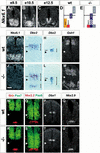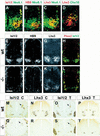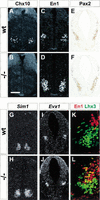Ventral neural patterning by Nkx homeobox genes: Nkx6.1 controls somatic motor neuron and ventral interneuron fates
- PMID: 10970877
- PMCID: PMC316892
- DOI: 10.1101/gad.820400
Ventral neural patterning by Nkx homeobox genes: Nkx6.1 controls somatic motor neuron and ventral interneuron fates
Abstract
There is growing evidence that sonic hedgehog (Shh) signaling regulates ventral neuronal fate in the vertebrate central nervous system through Nkx-class homeodomain proteins. We have examined the patterns of neurogenesis in mice carrying a targeted mutation in Nkx6.1. These mutants show a dorsal-to-ventral switch in the identity of progenitors and in the fate of postmitotic neurons. At many axial levels there is a complete block in the generation of V2 interneurons and motor neurons and a compensatory ventral expansion in the domain of generation of V1 neurons, demonstrating the essential functions of Nkx6.1 in regional patterning and neuronal fate determination.
Figures





Similar articles
-
Homeobox gene Nkx2.2 and specification of neuronal identity by graded Sonic hedgehog signalling.Nature. 1999 Apr 15;398(6728):622-7. doi: 10.1038/19315. Nature. 1999. PMID: 10217145
-
Different levels of repressor activity assign redundant and specific roles to Nkx6 genes in motor neuron and interneuron specification.Neuron. 2001 Sep 13;31(5):743-55. doi: 10.1016/s0896-6273(01)00412-3. Neuron. 2001. PMID: 11567614
-
Generation of oligodendrocyte precursor cells from mouse dorsal spinal cord independent of Nkx6 regulation and Shh signaling.Neuron. 2005 Jan 6;45(1):41-53. doi: 10.1016/j.neuron.2004.12.028. Neuron. 2005. PMID: 15629701
-
Together at last: bHLH and LIM-HD regulators cooperate to specify motor neurons.Neuron. 2003 Jun 5;38(5):675-7. doi: 10.1016/s0896-6273(03)00329-5. Neuron. 2003. PMID: 12797950 Review.
-
Sonic hedgehog: a common signal for ventral patterning along the rostrocaudal axis of the neural tube.Int J Dev Biol. 1995 Oct;39(5):809-16. Int J Dev Biol. 1995. PMID: 8645565 Review.
Cited by
-
CHD7 promotes neural progenitor differentiation in embryonic stem cells via altered chromatin accessibility and nascent gene expression.Sci Rep. 2020 Oct 15;10(1):17445. doi: 10.1038/s41598-020-74537-4. Sci Rep. 2020. PMID: 33060836 Free PMC article.
-
SONIC HEDGEHOG mutations causing human holoprosencephaly impair neural patterning activity.Hum Genet. 2003 Jul;113(2):170-7. doi: 10.1007/s00439-003-0950-4. Epub 2003 Apr 23. Hum Genet. 2003. PMID: 12709790
-
A direct requirement for Hedgehog signaling for normal specification of all ventral progenitor domains in the presumptive mammalian spinal cord.Genes Dev. 2002 Nov 15;16(22):2849-64. doi: 10.1101/gad.1025702. Genes Dev. 2002. PMID: 12435628 Free PMC article.
-
The requirement of Nkx2-1 in the temporal specification of cortical interneuron subtypes.Neuron. 2008 Sep 11;59(5):722-32. doi: 10.1016/j.neuron.2008.07.031. Neuron. 2008. PMID: 18786356 Free PMC article.
-
Linkage between Fuz and Gpr161 genes regulates sonic hedgehog signaling during mouse neural tube development.Development. 2024 Oct 1;151(19):dev202705. doi: 10.1242/dev.202705. Epub 2024 Oct 4. Development. 2024. PMID: 39369306
References
-
- Anderson SA, Eisenstat DD, Shi L, Rubenstein JL. Interneuron migration from basal forebrain to neocortex: Dependence on Dlx genes. Science. 1997;278:474–476. - PubMed
-
- Arber S, Han B, Mendelsohn M, Smith M, Jessell TM, Sockanathan S. Requirement for the homeobox gene Hb9 in the consolidation of motor neuron identity. Neuron. 1999;23:659–674. - PubMed
-
- Briscoe J, Sussel L, Serup P, Hartigan-O'Connor D, Jessell TM, Rubenstein JL, Ericson J. Homeobox gene Nkx2.2 and specification of neuronal identity by graded Sonic hedgehog signalling. Nature. 1999;398:622–627. - PubMed
-
- Briscoe J, Pierani A, Jessell TM, Ericson E. A homeodomain protein code specifies progenitor cell identity and neuronal fate in the ventral neural tube. Cell. 2000;101:435–445. - PubMed
-
- Burrill JD, Moran L, Goulding MD, Saueressig H. PAX2 is expressed in multiple spinal cord interneurons, including a population of EN1+ interneurons that require PAX6 for their development. Development. 1997;124:4493–4503. - PubMed
Publication types
MeSH terms
Substances
Grants and funding
LinkOut - more resources
Full Text Sources
Other Literature Sources
Molecular Biology Databases
Research Materials
